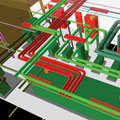

The actual name of this iconic New York City landmark and perhaps the most famous train depot in the world is Grand Central Terminal, be-cause trains originate and terminate there. They do not pass through.
The train station, which sits at 42nd Street and Park Avenue, opened in 1871. It was built by and named for the New York Central Railroad in the heyday of American long-distance passenger trains. Grand Central Terminal is the largest train station in the world with 44 platforms and 67 tracks along them. The terminal covers 47 acres.
The platform and track total will rise to 48 and 75 respectively when the Long Island Rail Road’s new station, below the existing levels, is slated to open in 2016.
That addition, dubbed East Side Access, is not the only construction in the works at Grand Central Terminal. A $21 million renovation is underway that will add a new employee facility and public tennis courts to the station’s annex. The anticipated completion date is this August.
When complete, Grand Central Terminal will boast large, historic windows in the annex that will bring light to the third floor for the first time in 70 years. The space, previously a three-story void, was the home of CBS studios from 1939 to 1964. More recently, Donald Trump leased the area as a tennis club and used ancillary offices to store his architectural materials. The 45,000-sq.-ft. renovations are the result of MTA Metro-North Railroad’s compli-ance with federal laws requiring quarters for railroad conductors and engineers. MTA Metro-North operates the terminal.
The BIM Fast Track
The use of 3-D technology has aided the annex project during the design and coordination phase. New York City-based Ziggurat Systems is provid-ing the building information modeling services on the project with its B4UB (Before You Build) software that provides a clash detection and space-management solution that enables a quicker and more confident transition to the construction phase.Ziggurat is working with F.J. Sciame Construction Co. on the design-build project. It’s one of the few projects in New York City where one entity - the design-builder - forges a single contract with the project owner to provide both architectural/engineering design services and construction ser-vices. Ziggurat is working closely with the Grand Central design and construction team to enhance construction documents and sequence field in-stallations throughout the project. New York City-based AKF Engineering is the design engineer on the project.
“Most people still design in 2-D. This is nothing new to us,” Ziggurat Senior Project ManagerDan Odedsays. “The designer worked in 2-D and we took their 2-D drawings and then swiftly converted them into the 3-D model.”
The BIM software allows all participants in the project to design using the same applications they use today without the capital investment and learning curve required when adopting new technologies.
Being able to detect potential design and coordination headaches in the early stages has helped keep the project pointing closer to comple-tion.
“We noticed it helped a lot with the required spaces in the ceilings where it was redesigned to accommodate all of the systems,” Oded notes. “We found clashes with steel beams and had to coordinate the openings with the steel beams. All of the redesign happened in the office rather than in the field. It’s a day’s work to try and correct those things in the field, especially when you work on design-build projects where times and schedules and getting to the field with everything coordinated and clash-free are very important.”
Using their proprietary software does not require a complete 3-D redesign on Ziggurat’s part, thus enhancing the time-management aspect.
“We take the same CAD drawings and convert them over to 3-D,” Oded says. “It’s a semiautomatic process. It picks the information from actual drawings. It takes about a week to enter a project and produce our first model and then we can do a floor in two days. It’s unique in the fact the process is very quick.”
Sciame Construction Project ManagerMelissa Steevessaw the service’s benefits in short order - long before the MEP installation started.
“It was helpful prior to the beginning of construction. We were able to identify conflicts with mechanical piping and sheet metal with structural beams and ceiling heights in the project space,” she says. “This allowed us to identify and install beam penetrations and adjust architectural elements of the building prior to the install of the mechanical trades’ work. This allowed for a smooth install for the MEP trades.”
Oded is impressed with how swiftly the technology was embraced.
“We offer a viewer that didn’t require them to have a lot of experience with it,” he says. “It helped them visualize their design. I like the fact people can see the design in 3-D and see the actual space and can see any issues early.”

Plumbing Solutions
Among the plumbing, heating and cooling elements installed in the renovation is a SyncroFlo duplex domestic water booster; Hubbell electric water heaters; Mammoth water-cooled DX units; a multistack water-cooled modular chiller; a Marley cooling tower; and Bell & Gossett hot water, chilled water and condenser water pumps. Kohler water closets and lavs, Crane urinals and Chicago Faucets shower components are in the restroom and showering areas. There are eight sets of restrooms and eight showering areas for conductors and engineers.“There was some interference with the plumbing and ductwork,” Oded states. “We were designing in tight spaces. Everything is above the ceiling there and we had to connect to existing systems. We had to coordinate the drain routes to avoid ducts. Pitched drains meant the routes needed an accurate design in order to be coordinated with the ductwork. We were able to locate clashes between the drains and the ductwork.”
Steeves isn’t able to put an exact time or dollar total on what the use of the BIM software has meant in terms of savings, but she knows the project has benefited tremendously from its use.
“We have not had any MEP conflicts with structural or architectural elements of the building,” she says.
The Way To Go
How beneficial on paper is the use of BIM technology? Oded references a Stanford University case study on a separate project that found the im-plementation of virtual coordination solutions like his company offers for the coordination of MEP systems yielded labor savings ranging from 20% to 30% for all MEP subcontractors. There was 100% prefabrication for the plumbing contractor; only one recorded injury throughout the installation of MEP systems over a 250,000 sq.-ft. project area; and less than 0.2% rework for the mechanical subcontractor over the whole project. Zero design conflicts occurred during field installation of the MEP systems on the Stanford case study. Relatively few requests for information were required dur-ing the coordination of the MEP systems.“People are joining this revolution. No question BIM is going to take over,” Oded predicts. “I don’t know if that will be in five years or 10 years. More and more companies are entering the BIM world.”

